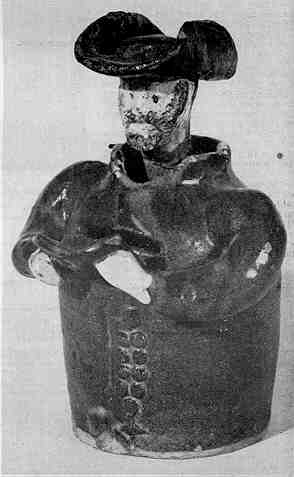Rare Pottery Mechanical Bank
by F.H. Griffith - HOBBIES Magazine - June, 1954
 The great majority of mechanical banks are made in cast iron. Then, of course,
there are some in tin, wood and tin, and the rarest most desirable of all, the
Freedman’s Bank, which is a combination of wood, metal and cloth.
The great majority of mechanical banks are made in cast iron. Then, of course,
there are some in tin, wood and tin, and the rarest most desirable of all, the
Freedman’s Bank, which is a combination of wood, metal and cloth.
A mechanical bank in pottery is a very unusual item and the one pictured is the only pottery mechanical bank the writer has ever come across.
There is a pottery alms box in the Metropolitan Museum of Art that is attributed to Han Dynasty 206 B.C. to 220 A.D. This is said to be Chinese origin and is a rectangular shaped chest supported by figure–like feet. There is a slot in the front, and on top a small figure of a bear somewhat broken. When a coin is deposited the bear bows forward. This piece, in the strictest sense, isn’t necessarily a mechanical bank, but it certainly is an early forerunner of the type.
As to the item pictured, it is definitely a mechanical savings bank and nothing else. It is made of a brown type clay with the coloring in the glaze. The figure is apparently that of a monk and the cloak and hat are a peculiar off-color purple. The face and hands are off-white in color and his beard, moustache, eyes and hair are the same color as his cloak and hat. The book he is holding has a small piece of printed paper pasted on the reading surface. The printing is in German.
The bank is five and three fourths inches high and four inches wide at the shoulders. The coin slot is located in his chest just in back of the book. The head and neck are suspended on the shoulders by a small metal rod molded in the neck. The neck is made so it fits down inside the body and on the end of the neck there is a small flat metal piece and a round weight.
In operating the bank a coin is inserted in the slot and it drops on the flat metal piece causing the head to nod back and forth. This action continues for some time and is similar to that of the nodding head figures.
The bank was found by George Wisecarver of Pittsburgh on one of his periodical antiquing trips to Europe. Mr. Wisecarver located the bank through the antiquarian Dr. W.A. Luz of Berlin, Germany. Dr. Luz in turn purchased it in Munich. He feels that the origin of the bank is probably Bavarian and that the figure represents a beggar monk and is connected in this way with the symbol of Munich. Dr. Luz thinks it is a very rare item of its kind, and he dates the bank around 1800 to 1820.
In any event, the bank is certainly an unusual piece and quite different from the usual types of mechanical banks.
